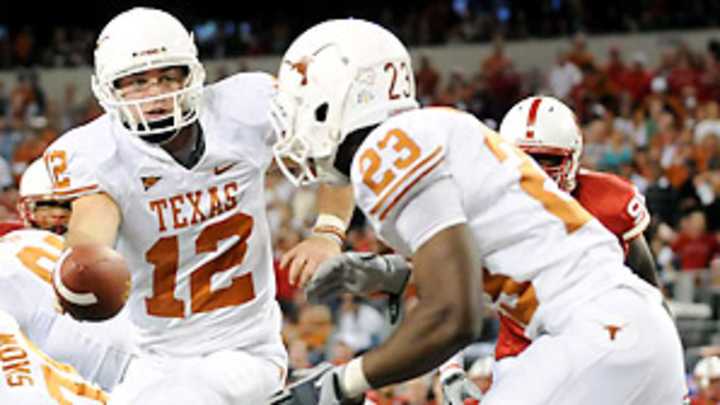To beat Crimson Tide, Longhorns must stick with the run


NEWPORT BEACH, Calif. -- Texas offensive coordinator Greg Davis has heard the criticism, and he agrees wholeheartedly. The Longhorns haven't been the most consistent running team. To win the national title Thursday, that will have to change.
"Well, I think [the criticism] is probably valid," Davis said Sunday. "We have not been able to run the ball as consistently as we would like. We're not interested in any kind of special number of rushing yards. We talk to our team about being consistent when we choose to run the ball. We need to stay balanced, especially in this ballgame. A lot of what we do comes off play action."
In other words, if Texas can't run, it also hurts the passing game. So Davis wants his team to be 60 percent efficient on runs to maintain a balance that keeps a defense on its heels. What is an efficient run? According to Davis, it's a designed run that either 1) gains four or more yards, 2) results in a first down or 3) results in a touchdown.
According to an analysis of every Texas rush this season, the Longhorns were 56 percent efficient against all opponents and 54.2 percent efficient against Big 12 opponents. It shouldn't surprise anyone that Texas ran with 34.5 percent efficiency in its narrow win against Nebraska in the Big 12 title game; what might surprise is that wasn't the Longhorns' worst rushing performance this season. That came in a 38-14 win against Colorado in which Texas rushed with 26.1 percent efficiency. The margin of victory may sound impressive, but it isn't as impressive when one takes into account Toledo's offense was far more effective against Colorado four weeks earlier.
The Longhorns' best rushing game, meanwhile, bailed them out of an unusually poor showing by the typically stout Texas defense. While the defense struggled to stop Texas A&M, the offense ran with 79.4 percent efficiency and kept the ball away from Aggies QB Jerrod Johnson long enough for the Longhorns to escape College Station with a 49-39 win.
My numbers will differ slightly from Davis', because he includes some screens and shovel passes in his count. Unfortunately, I don't have video of every play this season, and while Texas keeps intricately detailed play-by-play at home, its road opponents didn't always differentiate between types of passes. Also, Davis didn't count Colt McCoy scrambles in his numbers. But since McCoy's scrambles are a critical part of the Longhorns' run game and help keep an opposing defensive coordinator from releasing the hounds, I included them.MORE: Game-by-game numbers breakdown
Texas' current efficiency percentage probably doesn't inspire confidence against an Alabama defense that -- using Davis' metric -- only allowed 44.4 percent efficiency on opponents' runs this season. That makes sense; 355-pound nose tackle Terrence Cody eliminates most runs up the middle, and Alabama's speed at linebacker makes getting outside nearly impossible.
But the Longhorns shouldn't throw in the towel by throwing the ball exclusively. Instead, they should consider the only three opponents who threatened the Crimson Tide. Of the three, only LSU broke 50 percent efficiency (63.6), but Tennessee and Auburn used their ground attacks to keep games close.
Sunday, Alabama defensive coordinator Kirby Smart pointed out that the Tide's biggest scare came from a Tennessee team that, because of a lack of confidence in its passing game, refused to abandon the run. "That was one of our poorer performances," Smart said. "Not from the score outcome, but we were lucky a couple of times. They should have scored more points. They didn't abandon the run. They were stubborn with the run and kept running it, and they were pretty effective." The Volunteers, who had 16 efficient runs on 33 attempts, were a Cody-blocked field goal attempt away from spoiling Alabama's perfect season.
Two weeks later, LSU came to Tuscaloosa and ran the ball effectively until quarterback Jordan Jefferson -- an effective scrambler -- injured his ankle and tailback Charles Scott broke his collarbone. In spite of the injuries, the Tigers were still within one score late in the fourth quarter.
Perhaps most interesting are Alabama's final two games. On Nov. 27, Auburn jumped to a 14-0 lead against the Tide with two drives that included 10 runs and six passes. That percentage (62.5 percent run) was close to the Tigers' season run-pass percentage (57.9 percent run). Despite the ground game's role in building the lead, the Tigers ran little the rest of the day. In their 37 remaining plays, they ran just 18 times.
Meanwhile, Florida entered the SEC Championship having run the ball on 60 percent of its plays. Against the Tide, Florida ran 14 times and threw 35. The Gators abandoned the run long before Alabama built a big lead, and not because of a lack of success. They actually averaged 6.3 yards per carry. The Gators entered 12-0, but after allowing Alabama's defense to intimidate them into abandoning the run, they limped to a 32-13 loss.
Davis would do well to remember that Thursday. Even though Cody would scare any offensive coordinator, and even though the Longhorns didn't post an average of 432.4 yards a game by grinding it out on the ground, Texas must run to beat the Crimson Tide -- even if the running plays don't appear to be working. Texas players believe Davis, who almost certainly has examined these same statistics, will devise a plan to run enough to beat Alabama.
"We've won every bowl game since I've been here, and we have a lot of faith in coach Davis," senior offensive tackle Adam Ulatoski said. "He does a great job in game planning. It's just our job to go out there and execute his game plan."
